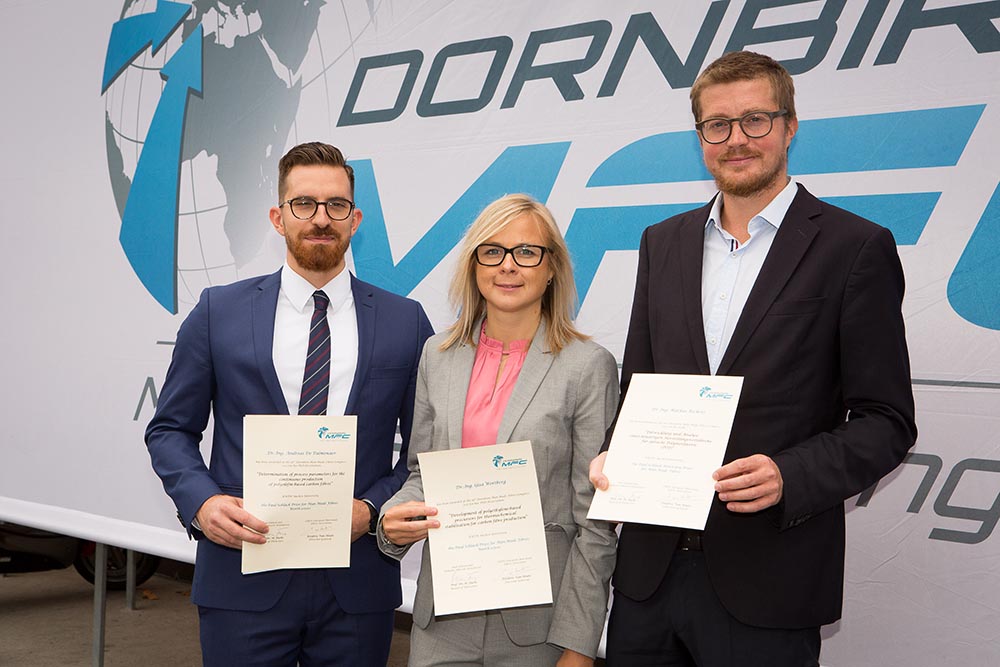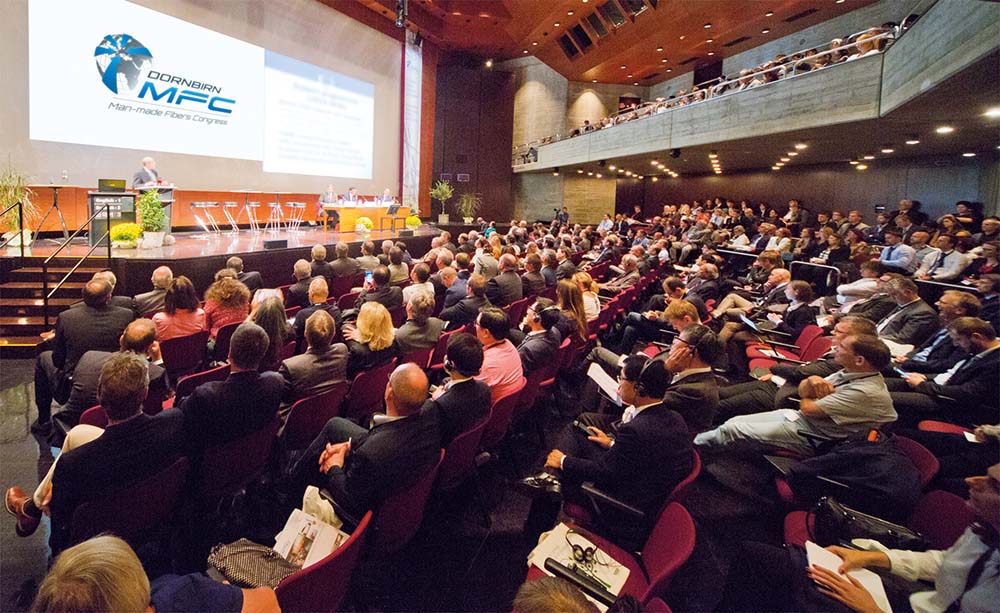
By
Faced with less-than-positive press reports and potentially damaging studies from non-governmental organizations, the European manmade fiber industry has been challenged to raise its game and take the lead in efforts to produce fibers responsibly and sustainably.
The take-home message from the 56th Dornbirn Man-Made Fibers Congress is that innovation is key for the industry and all producers have to work together in partnership along the whole supply chain in a world that is becoming increasingly digital and driven by the “millennial” generation of consumers.
The event featured more than 100 lectures, evenly split between industry and academic research. The key themes were fiber innovations, and fibers, textiles and nonwovens for healthcare and hygiene, protective applications, and sports and leisure wear.
The congress attracted more than 700 participants from over 30 countries, including a 30-strong delegation from China.
In addition to the plenary speeches and lectures, the three-day event included several panel discussions and a young scientists’ forum, as well as a recycling workshop.
Dark side
Opening the congress, Robert van de Kerkhof, chief commercial officer of Lenzing and president of the Austrian Fibers Institute, noted that the global fiber market is growing by 3-4% a year, with the highest growth in Asia, especially China.
Further, the technical textiles market is predicted to reach 42 million tons by 2020, where functionality is being applied to a range of new applications, such as architecture, automotive and sportswear.
“But there is a dark side to the industry: after petroleum, the fashion industry is one of the world’s most polluting industrial sectors,” van de Kerkhof reminded the audience.
For example, the manufacture of viscose could be sustainable, but is often not, owing to its prevalent production methods, according to Changing Markets Foundation.
Its recent report – Dirty Fashion – highlights the environmental and social impact of “dirty” viscose production, and in particular attacks brands and retailers, which puts pressure on fiber producers.
“But viscose can be a sustainable fiber made from wood and through recycling in the production process,” he said.
Meanwhile, the use of hazardous chemicals has been highlighted by Greenpeace’s Detox campaign, while the washing of garments made from non-biodegradable synthetic fibers has been shown to be an important source of microscopic fibers in the world’s seas, threatening wildlife and ending up in the food chain.
And while carbon fiber has the potential as lightweight, fuel-saving structural materials in the automotive and aerospace industries, its production is highly wasteful and it is a difficult material to recycle.
“All of this could discourage consumers from consuming and put them off certain brands and materials,” said van de Kerkhof. “But all along the value chain we have the opportunity to avoid wasteful products and polluting processes.”
“We as leaders can improve the industry by asking what are we doing ourselves. We have to raise the bar, state priorities, and show the brands and retailers that it is possible to produce fibers responsibly and sustainably.”
Misconceptions
Dr. Heinz Meierkord, president of CIRFS, the European Man-made Fibres Association, and chief executive officer of Advansa, noted that manmade fibers accounted for 68% of global fiber production in 2016, followed by cotton with 24%.
He debunked several misconceptions about natural fibers, namely that they: are “better for the environment”, use a limited number of natural resources, are fully renewable, are less toxic, and that their eco-footprint is better than manmade fibers.
Meierkord pointed out that 2.4% of the world’s arable land is planted with cotton, 24% of insecticides and 11% of the global sales of pesticides are used for growing cotton, and that sheep contribute to emissions of greenhouse gases, with woolgrowers often using pesticides and fertilizers to improve pasture yields.
Meanwhile, some manmade fibers are produced from renewable resources such as trees, manmade fibers based on oil-based feedstock use only around 1% of global oil production, and the use of recycled materials as a raw material is growing rapidly, including the recycling of PET bottles, waste fishing nets, carpets and ropes, etc.
Further, manmade fibers are more durable than natural fibers, the shelf life of synthetic fabrics is longer, washing can take place at lower temperatures, and they dry quickly, without the need for ironing.
In many industrial applications, manmade fibers can also provide properties of light weight, high strength and protection from weather, as well as being used in geotextiles, medical textiles and filtration.
Paul Schlack awards
During the congress the Paul Schlack/Wilhelm Albrecht Prize 2017 was awarded to two researchers working on the development of polyethylene-based carbon fibers as part of their doctorates at the Institut für Textiltechnik (ITA) at RWTH Aachen, Germany.
Dr. Gisa Wortberg focused on the development of polyethylene-based carbon fibers for thermochemical stabilization, while Dr. Andreas De Palmenaer worked on the conversion of the polyethylene-based precursors.
The researchers demonstrated the technical feasibility of using polyethylene as an alternative precursor material for carbon fiber, as well as the ability to control the process chain and its economic potential.
Meanwhile, the Paul Schlack Honorary Prize 2017 was awarded to ITA’s Dr. Markus Beckers for the development and analysis of a new manufacturing process for polymer optical fibers.

Circular economy
Held on the day prior to the congress opening, a recycling workshop, chaired by Syngroup Management Consulting of Austria, focused on the “Circular Economy: Textile and Nonwovens Waste – a threat or opportunity?”
This topical subject was examined by some 45 experts drawn from the fiber industry and downstream manufacturing stages, trading firms and waste management companies. Brands such as Ikea and Adidas were represented, as well as the EU Commission.
The workshop was jointly organized by Dornbirn-MFC in cooperation with CIRFS, EDANA (the international association serving the nonwovens and related industries) and the International Solid Waste Association.
Sustainability contradiction
In a panel discussion moderated by Giuseppe Gherzi, of Gherzi Consulting, Switzerland, on sustainability and performance in the sports and leisure wear industry, the key message was that brands/retailers should work with the entire value chain. However, the question remains as to who should drive sustainability.
Ranil Vitarana of MAS Holding, Sri Lanka, noted that the textile industry is extremely fragmented, “but sustainability should be driven by Europe. However, there needs to be a cohesive plan to implement it faster.”
Rene Bethmann of Vaude, Germany, said consumers will only pay more for a “sustainable” product if they can see real advantages. Kate Riley of Adidas, Germany agreed, adding that change will be dependent on what the consumer is prepared to pay, while Dieter Backhaus of Invista, Germany, argued that the industry should focus on women as the key consumers.
Next congress
The newly rebranded 57th Global Fiber Congress Dornbirn will be held on September 12-14, 2018 with the main topics:
- Fiber innovations
- Transport and mobility
- Recycling
- Energy storage
- Surface modification and additives
- Additive technologies.
Companies and organizations interested in making a presentation should email the Austrian Fibers Institute including the working title, short summary and contact details.
For more information contact:
Austrian Fibers Institute
Tel: +43-1-319-2909
Fax: +43-1-3192-90931
Email: office@austrian-mfi.at
Website: www.dornbirn-mfc.com


